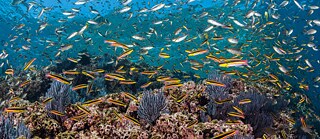Ecosystems
Coral Reefs: Fortresses of Resistance

Coral reefs are ecosystems that boast very great biodiversity but are highly endangered. The “climate refugee” super corals could offer some unexpected help and possibly ensure the survival of the reefs.
By Fabio Arturo López Alfaro
Coral reefs are some of the world’s most varied and biodiverse ecosystems. They are impressive not only because of their beauty, however: for people living in coastal areas they are of inestimable value, both in social and economic terms, as well as for the environment. Corals account for less than one percent of the total surface area of the oceans, yet are home to 25 percent of marine species. They are also important because they protect coasts from erosion and provide people with food and a source of income from tourism and fishing. Nonetheless, they are at risk of being destroyed due to local climate changes and anthropogenic stressors.
Even if the target laid down in the Paris Agreement is achieved and global warming is limited to 1.5 degrees Celsius, the situation will have already deteriorated to such an extent that at least three quarters of all coral reefs will disappear. 2 degrees of warming would result in the almost complete destruction of all reefs in tropical and subtropical regions. This would be a bitter loss – not only for the inhabitants of coastal areas, but for the entire planet.
Biosystems in Extreme Danger
The most obvious proof that these peculiar creatures are suffering is coral bleaching. Healthy corals are usually greenish or brown in colour. This is because of the zooxanthellae, the photosynthetic algae with which they live in symbiosis and thus in direct metabolic exchange. When the corals become stressed over an extended period, however, they expel the zooxanthellae. As their tissue is gradually revealed, the whiteish skeleton that gives corals their shape shimmers through.Such stress is caused for example by an oversupply of nutrients, sediment suspension or the consequences of climate change, such as a rise in water temperature, acidification of the oceans or particularly severe meteorological phenomena.
It is already possible to predict the changes that these ecosystems will face. In the IPCC Fifth Assessment Report from 2014, corals were classified as highly endangered given the expected rise in global temperatures of 2.6 degrees. Just four years later – in the IPCC Special Report on Global Warming of 1.5 degrees – this assessment was amended to “very highly endangered”. Even a rise of 1.5 degrees would mean the loss of 70 to 90 percent of all coral reefs.
Their future looks anything but rosy, in other words, and preserving these special ecosystems is a huge challenge, as current predictions assume that we will see even higher increases in temperature.
Super Corals: Can They Ensure the Survival of the Reefs?
There is one glimmer of hope, however: the so-called super corals. According to the marine biologist Emma Camp, these are organisms that have high chances of survival even under unfavourable conditions. Super corals are resistant species that settle in new ecosystems which, though conditions there may not be optimal, do offer at least a kind of oasis in an increasingly warm ocean.In 2019 Camp published a study in which she was able to demonstrate that corals have now for the first time colonised the mangrove lagoons of the Great Barrier Reef at Woody Isles and Howick Island. Before climate change began having an impact, corals and mangroves would never share the same habitat. Due to the migration of increasing numbers of organisms to regions with better living conditions, we are seeing a restructuring of ecosystems today.
As yet, the effects of these changes are difficult to predict. However, the realization that these unusual “climate refugees” are able to find a safe haven in certain areas could offer a new research approach and help preserve the corals.
The Mesoamerican Reef
The world’s second-largest coral reef stretches along the coasts of Belize, Honduras, Guatemala and Mexico: the Mesoamerican Reef. What makes this reef so special is not only its dimensions but also the fact that it provides a habitat for a large number of different species, some of which are threatened by extinction. Furthermore, the Mesoamerican Reef also provides coastal inhabitants with the basis for their incomes, their food supply and their lifestyles.Despite its importance, more than half of the reef is nowadays considered to be damaged. For the most part, the causes are activities that have a direct impact on the region, such as overfishing and agriculture or the development of coasts and tourism.
To counteract this, so-called “underwater nurseries” were set up in which particularly resistant corals are cultivated. In addition, preparations are underway to tackle future problems so that damage can be mitigated and sustainable tourism and business promoted.
Humankind is facing the huge challenge of preserving life; though the future does not look all that bright, life is characterised precisely by the fact that it always seeks to secure its continued existence in one way or another. For this reason we should not write off corals just yet: they are true fortresses of resistance.